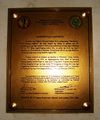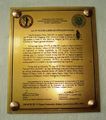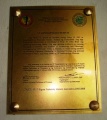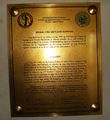Palma Hall
(PAGE STILL UNDER CONSTRUCTION)
Palma Hall (more commonly known today as "AS" to the UP Community) is located on Roxas Avenue along the Academic Oval of the University of the Philippines Diliman, Quezon City. It was named after Rafael Palma (1874-1974), who served as president of the university from 1923 to 1933. It currently houses the College of Social Sciences and Philosophy (CSSP).
Palma Hall is also where most of the courses of the Revitalized General Education Program (RGEP) are being held, thus making it one of the most frequented buildings in the university. Because of its location and space, it is also where special events and activities are held, such as student demonstrations, student organization booths and exhibits, as well as the famous Oblation Run, among others.
<googlemap lat="14.654012" lon="121.069014" width="400" height="300"> 14.653577, 121.069799 Palma Hall, UP Diliman </googlemap>
History
A. Palma Hall Building
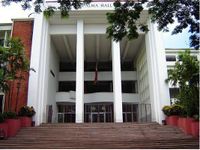
Palma Hall used to be the home of the College of Liberal Arts, at present, it is more commonly known as "AS", and currently houses the College of Social Sciences and Philosophy. It was named after Rafael Palma (1874-1974), who served as president of the university from 1923 to 1933. Rafael Palma formally assumed the Presidency of the University of the Philippines on July 18, 1925 after having served as acting President for nearly two years.
The building was finished in 1951.
B. College of Arts and Sciences
Palma Hall is commonly known as “AS”, which was derived from its previous name, College of Arts and Sciences. Although it was officially formed and named as CAS only in 1959, the history of the College of Arts and Sciences dates back to the year 1910, with the formation of the College of Liberal Arts.
The College of Liberal Arts was established in June of 1910 by the UP Board of Regents. Previously called the Junior College of Liberal Arts, the college previously existed as in institution operated by the Bureau of Education of the Department of Public Instruction. The CAS had two units: (1) the Junior College, which offered the degree of Bachelor of Arts after two years of study, and (2) the Senior College, which offered the degree of Master of Arts after three years of study.
Upon the start of Academic Year 1959-1960, the College of Liberal Arts was reorganized into three separate units being served by only one faculty: (1) the University College, which was tasked with teaching general education courses; (2) the College of Arts and Sciences, which offered undergraduate courses as fields of specialization and focused on the third and subsequent years of education; and (3) the Graduate School of Arts and Sciences, which catered to those who would pursue their Masters and Doctorates after graduation from the University.
On October 26, 1983, the UP Board of Regents issued Administrative Order No. 170, which created three new colleges from the former College of Arts and Sciences: (1) the College of Social Sciences and Philosophy (CSSP), (2) the College of Arts and Letters (CAL), and (3) the College of Science.
Palma Hall now houses CSSP, while CAL and CS have their own buildings. [1]
Parts of AS
A. AS Lobby
-
Plaque found outside the "Basement"
AS Canteen - known at present as the "Basement", the AS Canteen used to be the meeting place of the artists and scientists of UP where they used to hold intellectual debates in the 60's and 70's. Some of the topics were Existentialism and Marxism. A prominent figure in the canteen was Salome Flores, more popularly known among the students as "Mommy". The canteen was closed in the 90's. At present, it serves as the office of the Archeological Studies Program.
-
Plaque at the AS 2nd floor Lobby
AS 2nd floor Lobby - during the latter part of the 70's, the AS 2nd floor Lobby became known as the "Second Floor Republic" among the student activists. It served as the 'tambayan' of three activist fraternities/sororities; the Pi Sigma/Pi Sigma Delta, the Sigma Kappa Pi/Sigma Delta Pi, and the Alpha Sigma/Sigma Alpha Nu, and other organizations such as Kalilayan, Asylum and Kutang Bato.
AS 209 - served as the office of the UP President from 1951-1956. Used by then UP President, Vidal A. Tan.
AS 207 - served as the meeting place of the Consultative Committee on Student Affairs (CONCOMSA) from 1974-1975. The CONCOMSA was a group of students in charge of preparing the return of the UP Student Council (USC) which was abolished during the Martial Law in 1972. It also served as the office of the AS Student Council, SINAG and the Freshmen Orientation Program Committee (FOPC).
-
Plaque beside "Mga Natatanging Pilipino"
2nd floor Mural "Mga Natatanging Pilipino" - the mural was made by the UP Artists' Circle Fraternity in 1996. It features exceptional Filipinos who played important roles in the Propaganda Movement (1882-1892), the EDSA Revolution (1986) and other student leaders.
B. AS Steps
C. AS Walk
AS Walk spans the entire length of Palma Hall. It is home to many student organizations of the university, usually filled with booths put up by different student orgs. AS Walk is also where the Third World Library is found. CSSP houses the Third World Studies Program, an academic research institute committed to analyze and develop alternative perspectives on Philippine, regional, and global issues.
D. AS 101
AS 101 is the Office of the College Secretary for CSSP. This is where the enrolment of CSSP students takes place, and where they can get their TCG (True Copy of Grades), dropping slips, ChangeMat slips (Change of Matriculation), and registration materials (Form 5 and Form 5A) during enrolment.
E. East and West Wings
F. Third World Library
The Third World Studies Center is found along the AS Walk. The Third World Studies Center (TWSC) of the University of the Philippines is an academic research institute based at the College of Social Sciences and Philosophy (CSSP), committed to analyze and develop alternative perspectives on Philippine, regional and global issues. [2]
G. Wilfrido Ma. Guerrero Theater
-
Plaque outside the Guerrero Theatre (AS 2nd floor Lobby, UP Diliman)
Found at the AS 2nd floor Lobby, the theatre, which was named after Wilfrido Ma. Guerrero in 1976, is dedicated to the former director of the UP Dramatic Club. The theatre was first opened on September 16, 1976 and was inaugurated by the UP Dramatic CLub with the play, "I Remember Mama". Renovation of the theatre was completed in the year 2000 through the efforts of Claro T. Llaguno (UP Diliman Chancellor, 1996-1999), Emerlinda Roman (UP Diliman Chancellor, 1999-2000) and Leonor M. Briones (Treasure of the Philippines, Bureau of the Treasury).
H. Anthropology Museum
-
Plaque outside the Anthropology Museum (AS 2nd floor)
The Anthropology Museum, found at the AS 2nd floor, was opened on July 13, 1967 through the efforts of then University Secretary, Iluminada Panlilio. Its first exhibit featured Prof. H. Otley Beyer's collection of archeological and ethnological artifacts which he had gathered from 1905 to 1926. The said collection was first featured in 1668 at the Museum and Institute of Archeology and Ethnology in Aviles Street, Manila which was destroyed during the 2nd World War. In 1961, Beyer was offered by the University of the Philippines several rooms on the third floor, east wing of Palma Hall to house his collection. "The rooms were kept for several years until... due to the shortage of classrooms, the rooms were gradually encroached upon, until only one big single room was left, all the collections were transferred here where they remained until his (Beyer's) demise." (Noriega, 1978) Natividad Noriega, Beyer's personal secretary, served as the museum's first curator. The Anthropology Museum has two sections; Section A (Prehistory and Archeology) and Section B (Ethnography). (Source: Museum of Anthropology Brochure, 1978)
Artworks of Palma Hall
A. AS Lobby mural
-
Plaque found below the AS Mural
The mural at the AS Lobby, entitled "The Arts and Sciences", was made by National Artist, Vicente Manansala in 1960. With a length of 14 meters and a width of 2 meters, "The Arts and Sciences" is the biggest mural in the UP Diliman Campus.
B. AS Lobby floor design
The floor of the AS Lobby has a terrazzo granolithic design.
C. Second floor mural
Entitled "Mga Natatanging Pilipino" (Exceptional Filipinos), this mural made by the UP Artists' Circle Fraternity features prominent Filipino figures of the Propaganda Movement, the Katipuneros, the First EDSA Revolution, etc.
D. Jose Rizal busts
Surrounding Buildings
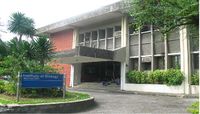

A. Benton Hall
Benton Hall is located to the east of Palma Hall, also facing the Academic Oval. It houses the Center for International Studies (CIS), as well as offices like the Office of Anti-Sexual Harassment (OASH) and the UP Diliman Gender Office (UPDGO).
B. Palma Hall Annex/PHAn
The Department of Psychology is one of the few departments in the university which has its own building - the Palma Hall Annex (PHAn), which, being connected to Benton Hall, is located between Palma Hall and Benitez Hall (College of Education). Graduate and undergraduate courses are held in classrooms in the second and third floors of PHAn. [3]
C. CASAA
The College of Arts and Sciences Alumnae Association food center, more commonly known as CASAA, is located just across the street from the east wing of Palma Hall, in between Benton Hall and the Institute of Biology. It is an open cafeteria/ food court that serves different kinds of food. It currently houses 8 food establishments: Gloria's (which has 2 stalls facing each other), Chef's Grille, Chinatown, Sizzler, Mongolian Grill, Big Kids (?), Pasta House (?), and the soda fountain, which serves only softdrinks and ice cream.
D. Institute of Biology
Located to the east of Palma Hall and facing Quirino Avenue, the Institute of Biology of the University of the Philippines Diliman is the premiere institution on the Philippines for higher learning and research in biology [4]. It houses some classrooms and laboratories, as well as the administration offices of the Institute of Biology.
E. Science Pavilions
The Science Pavilions consist of four separate buildings located right behind Palma Hall, facing Quirino Avenue. These buildings house the laboratories for Biology, Chemistry, and Physics. The first building across the street from the Institute of Biology is the Biology Pavilion; next to it is the Physics Pavilion; and the other two buildings at the west side of Palma Hall are the Chemistry Pavilions.
F. Bulwagang Rizal/Faculty Center
The Bulwagang Rizal or the Faculty Center, more commonly known as FC, is found to the west of Palma Hall. It houses the rooms for the faculty of CSSP and CAL. It also houses different departments of both colleges, such as the departments of Anthropology, Geography, Filipino Studies, Art Studies, etc.
References and External Links
Palma Hall
Art Studies 2 THR-2
Sir Roberto G. Paulino
Report by:
Kristina Camua
Karina Gonzales
Sharmaine Gonzales
(LIST OF REFERENCES AND LINKS)

